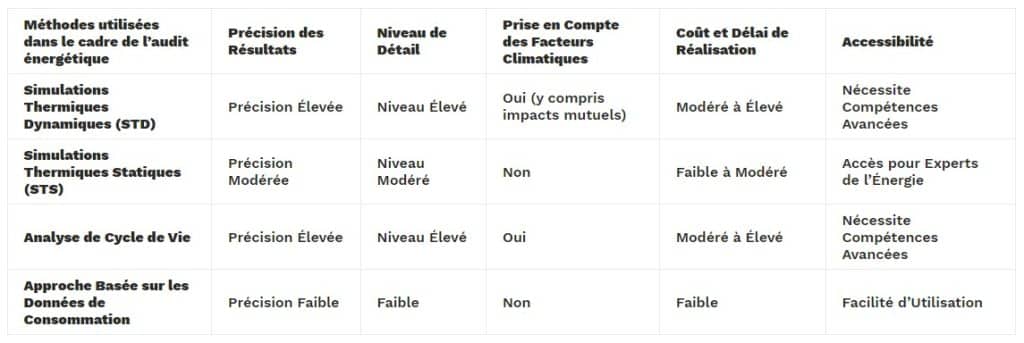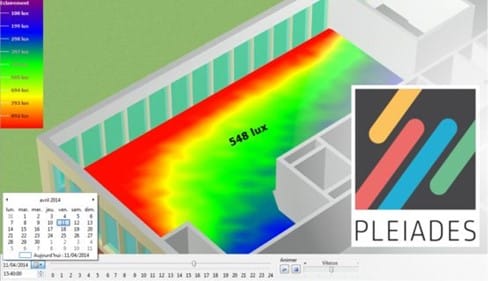Energy efficiency is the basis for the design and management of tertiary buildings. With this in mind, energy audits are essential guides, providing the data needed to optimize performance. Among audit methods, dynamic thermal simulations stand out for their precision and level of detail. This article takes a deep dive into these audits based on dynamic thermal simulations, exploring their benefits, comparing them to traditional methods and revealing how Sobre Energie harnesses this potential for a promising energy future and energy performance actions to be realized in documented multi-year plans and therefore more easily financed.
Energy Audit Methods: an overview to make the best choices according to your needs for your tertiary buildings
Energy audits of tertiary buildings use various methods, each presenting its own strengths and limitations. Here is an overview of the main approaches:

Harnessing the Potential of Thermal Dynamic Simulations (STD)
Dynamic thermal simulations offer a multitude of benefits:
Precision Grounded in Physical Reality
Dynamic thermal simulations go beyond simple energy performance analysis. Based on detailed modeling, they provide high precision ensuring that each calculation and each result is rooted in the physical reality of the building. This precision provides a solid basis for informed decisions regarding energy efficiency.
Exploring Various Scenarios
One of the major strengths of dynamic thermal simulations is their ability to enable careful exploration of various scenarios. With a high level of detail, they become a virtual testing ground for testing different energy efficiency solutions and strategies. This ability to explore favors the identification of the best options.
For public buildings in the city of Bézier, the simulations carried out by Sobre Energie take into account variable occupancy and intensive use during heatwave periods, thus allowing optimized management of thermal comfort and air quality interior.
Capturing Complexity
The true strength of dynamic thermal simulations lies in their ability to capture the complexity of a building's exterior and interior environment. Going beyond a simple assessment of climatic factors, they integrate the mutual interactions of energy efficiency measures. This holistic approach anticipates unforeseen impacts and enables overall optimization .
For example, the STDs take into account the combined effects of windows and lighting on interior temperature, allowing automobile dealerships members of the MOBILIANS of which Sobre Energie is a partner to plan integrated energy improvements.
Temporal Continuity with STD
Unlike the STS which focuses on winter losses, the STD offers an analysis over the entire year, thus offering a complete and continuous vision of energy performance rather than a simple one-off photograph.
Comfort of Occupants as a Priority
Integrating occupant comfort is another pillar of the benefits of dynamic simulations. Beyond consumption figures, they take into account the thermal sensation, the homogeneous distribution of heat and light. The objective is to create an optimal interior environment for occupants by considering their well-being.
Fine Management of Climate Conditions and taking into account changes in global warming
Simulations are not limited to fixed Unified Degree Day (UDD) data to assess climate variations. They precisely integrate fluctuations, such as the force of the wind on the facade and the fine orientation of the building in relation to the sun. Brightness calculations play a crucial role in effective daylight management, reducing the need for artificial lighting.
Aeraulic Optimization
Dynamic thermal simulations also include aeraulic aspects. By carrying out precise calculations of air exchanges, they allow a better understanding of air circulation inside the building. This contributes to the optimization of ventilation systems, ensuring optimal indoor air quality.
This is the case as part of Sobre Energie’s support for the Nord department and its Sustainable North plan .
Advanced Exploration
Additional calculations include factors that are often overlooked, such as air humidity without wall interference, specific artificial lighting requirements and associated consumption. The simulations go further, exploring advanced aspects such as the impact of climate well ventilation on indoor comfort or the effect of variable inertia over time. These aspects take on particular importance for specific buildings, such as warehouses or wineries.
Integration of Renewable Energy
Finally, these simulations offer the advantage of allowing the evaluation of the production of a photovoltaic installation. This assessment explores how renewable energy, such as solar photovoltaics, can be effectively integrated into the building to maximize its energy efficiency and sustainability. The regulatory context with the APER law of March 10, 2023 systematically pushes Sobre Energie to offer this type of Energy Performance Action in our simulations.
Sobre Energie: Making the most of business tools in terms of STD
Sobre Energie positions itself at the forefront of energy solutions by using the COMFIE calculation engine for audits of tertiary buildings. Developed by Pleiades (publisher IZUBA), this engine is based on advanced modeling, using a multi-zone finite difference model reduced by modal analysis.
This approach precisely calculates the energy needs of each zone of the building at each moment, while taking into account thermal interactions.
The alliance of expertise and technology allows Sobre Energie to offer detailed and tailor-made energy audits, paving the way for sustainable and concrete solutions for tertiary buildings. All Sobre Energie STDs are AFNOR compliant and Sobre Energie has OPQIBI certification.

Digitalization of Audits with DATAMARC: The Powerful Combination with STDs
In addition to the intrinsic advantages of STDs, the digitalization of audits with the DATAMARC platform brings an additional dimension to the energy audit.
This combination allows us to go beyond a simple photograph of the situation of the tertiary building:
- Unified Vision of Consumption : A consolidated view of consumption data for all audited buildings.
- Strategic Recommendations : Integration of a recommendation plan for energy optimization, with monitoring of returns on investment.
- Budget Monitoring : Clarity on the costs associated with each recommendation, facilitating decision-making.
The combination of the dynamic dimension of STDs and the digitalization of audit data is a crucial management lever. It facilitates investment and management choices, maximizing the performance of tertiary buildings.
Towards more informed choices of energy performance actions
In the landscape of energy audits for tertiary buildings, dynamic thermal simulations are emerging as pillars of precision. However, each method has its place, meeting specific needs. To explore technical solutions in depth, dynamic energy simulation is a valuable tool, propelling informed choices for energy-efficient buildings and resolutely focused on optimized energy performance action projects whose ROI is established with the best business indicators of the market. This is the first optimal step to take action and achieve the priority objectives of -40% energy savings for 2030 within the framework of the tertiary decree.
